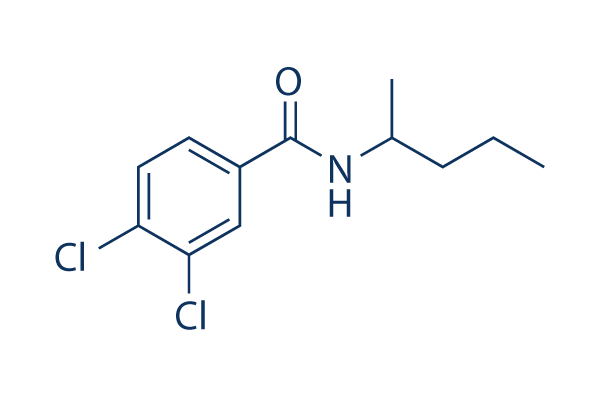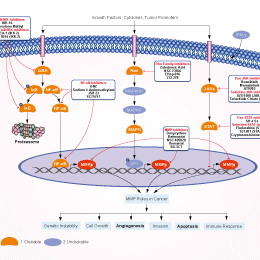
- Bioactive Compounds
- By Signaling Pathways
- PI3K/Akt/mTOR
- Epigenetics
- Methylation
- Immunology & Inflammation
- Protein Tyrosine Kinase
- Angiogenesis
- Apoptosis
- Autophagy
- ER stress & UPR
- JAK/STAT
- MAPK
- Cytoskeletal Signaling
- Cell Cycle
- TGF-beta/Smad
- DNA Damage/DNA Repair
- Compound Libraries
- Popular Compound Libraries
- Customize Library
- Clinical and FDA-approved Related
- Bioactive Compound Libraries
- Inhibitor Related
- Natural Product Related
- Metabolism Related
- Cell Death Related
- By Signaling Pathway
- By Disease
- Anti-infection and Antiviral Related
- Neuronal and Immunology Related
- Fragment and Covalent Related
- FDA-approved Drug Library
- FDA-approved & Passed Phase I Drug Library
- Preclinical/Clinical Compound Library
- Bioactive Compound Library-I
- Bioactive Compound Library-Ⅱ
- Kinase Inhibitor Library
- Express-Pick Library
- Natural Product Library
- Human Endogenous Metabolite Compound Library
- Alkaloid Compound LibraryNew
- Angiogenesis Related compound Library
- Anti-Aging Compound Library
- Anti-alzheimer Disease Compound Library
- Antibiotics compound Library
- Anti-cancer Compound Library
- Anti-cancer Compound Library-Ⅱ
- Anti-cancer Metabolism Compound Library
- Anti-Cardiovascular Disease Compound Library
- Anti-diabetic Compound Library
- Anti-infection Compound Library
- Antioxidant Compound Library
- Anti-parasitic Compound Library
- Antiviral Compound Library
- Apoptosis Compound Library
- Autophagy Compound Library
- Calcium Channel Blocker LibraryNew
- Cambridge Cancer Compound Library
- Carbohydrate Metabolism Compound LibraryNew
- Cell Cycle compound library
- CNS-Penetrant Compound Library
- Covalent Inhibitor Library
- Cytokine Inhibitor LibraryNew
- Cytoskeletal Signaling Pathway Compound Library
- DNA Damage/DNA Repair compound Library
- Drug-like Compound Library
- Endoplasmic Reticulum Stress Compound Library
- Epigenetics Compound Library
- Exosome Secretion Related Compound LibraryNew
- FDA-approved Anticancer Drug LibraryNew
- Ferroptosis Compound Library
- Flavonoid Compound Library
- Fragment Library
- Glutamine Metabolism Compound Library
- Glycolysis Compound Library
- GPCR Compound Library
- Gut Microbial Metabolite Library
- HIF-1 Signaling Pathway Compound Library
- Highly Selective Inhibitor Library
- Histone modification compound library
- HTS Library for Drug Discovery
- Human Hormone Related Compound LibraryNew
- Human Transcription Factor Compound LibraryNew
- Immunology/Inflammation Compound Library
- Inhibitor Library
- Ion Channel Ligand Library
- JAK/STAT compound library
- Lipid Metabolism Compound LibraryNew
- Macrocyclic Compound Library
- MAPK Inhibitor Library
- Medicine Food Homology Compound Library
- Metabolism Compound Library
- Methylation Compound Library
- Mouse Metabolite Compound LibraryNew
- Natural Organic Compound Library
- Neuronal Signaling Compound Library
- NF-κB Signaling Compound Library
- Nucleoside Analogue Library
- Obesity Compound Library
- Oxidative Stress Compound LibraryNew
- Plant Extract Library
- Phenotypic Screening Library
- PI3K/Akt Inhibitor Library
- Protease Inhibitor Library
- Protein-protein Interaction Inhibitor Library
- Pyroptosis Compound Library
- Small Molecule Immuno-Oncology Compound Library
- Mitochondria-Targeted Compound LibraryNew
- Stem Cell Differentiation Compound LibraryNew
- Stem Cell Signaling Compound Library
- Natural Phenol Compound LibraryNew
- Natural Terpenoid Compound LibraryNew
- TGF-beta/Smad compound library
- Traditional Chinese Medicine Library
- Tyrosine Kinase Inhibitor Library
- Ubiquitination Compound Library
-
Cherry Picking
You can personalize your library with chemicals from within Selleck's inventory. Build the right library for your research endeavors by choosing from compounds in all of our available libraries.
Please contact us at info@selleckchem.com to customize your library.
You could select:
- Antibodies
- Bioreagents
- qPCR
- 2x SYBR Green qPCR Master Mix
- 2x SYBR Green qPCR Master Mix(Low ROX)
- 2x SYBR Green qPCR Master Mix(High ROX)
- Protein Assay
- Protein A/G Magnetic Beads for IP
- Anti-Flag magnetic beads
- Anti-Flag Affinity Gel
- Anti-Myc magnetic beads
- Anti-HA magnetic beads
- Poly DYKDDDDK Tag Peptide lyophilized powder
- Protease Inhibitor Cocktail
- Protease Inhibitor Cocktail (EDTA-Free, 100X in DMSO)
- Phosphatase Inhibitor Cocktail (2 Tubes, 100X)
- Cell Biology
- Cell Counting Kit-8 (CCK-8)
- Animal Experiment
- Mouse Direct PCR Kit (For Genotyping)
- New Products
- Contact Us
NSC 405020
NSC 405020 is a noncatalytic inhibitor of MT1-MMP, directly interacts with PEX domain of MT1-MMP, affects PEX homodimerization but not catalytic activity of MT1-MMP.

NSC 405020 Chemical Structure
CAS No. 7497-07-6
Purity & Quality Control
NSC 405020 Related Products
| Related Targets | MMP1 MMP2 MMP3 MMP7 MMP8 MMP9 MMP12 MMP13 MMP14 MMP26 | Click to Expand |
|---|---|---|
| Related Products | Ilomastat (GM6001) Batimastat (BB-94) SB-3CT Marimastat (BB-2516) Nobiletin T-5224 MMP-9-IN-1 JNJ0966 Cordycepin 1, 10-Phenanthroline monohydrate o-Phenanthroline Lactobionic acid Auraptene CL-82198 | Click to Expand |
| Related Compound Libraries | FDA-approved Drug Library Natural Product Library Bioactive Compound Library-I Protease Inhibitor Library Ubiquitination Compound Library | Click to Expand |
Signaling Pathway
Biological Activity
| Description | NSC 405020 is a noncatalytic inhibitor of MT1-MMP, directly interacts with PEX domain of MT1-MMP, affects PEX homodimerization but not catalytic activity of MT1-MMP. | |
|---|---|---|
| Targets |
|
| In vitro | ||||
| In vitro | NSC 405020 is a noncatalytic inhibitor of MT1-MMP, directly interacts with PEX domain of MT1-MMP. NSC 405020 affects PEX homodimerization but not catalytic activity of MT1-MMP. NSC 405020 (100μM) inhibits migration of cells with high level of MT1-MMP, with a reduction of migration efficiency by about 75%. NSC 405020 does not inhibit migration of cells with low level of MT1-MMP and does not inhibit cell adhesion on collagen.[1] | |||
|---|---|---|---|---|
| Kinase Assay | Migration assays | |||
| Assays are conducted in wells of a 24-well, 8 μm pore size Transwell plate. A 6.5-mm insert membrane is coated with 0.1 mL COL-I (300 μg/mL in MEGM) and then air dried for 16 hours. The collagen coating is rehydrated for 1 hour in 0.2 mL MEGM. The inner chamber contains MEGM-10% FBS as a chemoattractant. The compounds (10–100 μmol/L) or DMSO (0.1%–1%) are added to both inner and outer chambers. Before plating in the outer chamber, cells (5×104) are coincubated for 20 minutes with the compounds or DMSO in MEGM. Cells are allowed to migrate for 16 to 18 hours. The cells remaining on the top surface of the membrane are removed with a cotton swab. The cells on the bottom surface of the membrane are fixed and stained (0.2% crystal violet). The incorporated dye is extracted with 1% SDS and the A570 is measured. | ||||
| Cell Research | Cell lines | 184B5-MT and MCF7-β3/MT | ||
| Concentrations | ~400 μM | |||
| Incubation Time | 24 or 30 h | |||
| Method | Assays are conducted in wells of a 96-well flat bottom, white wall plates. 184B5-MT and MCF7-β3/MT cells (5×104) are grown for 16 hours in MEGM-10% FBS and DMEM-10% FBS, respectively. 184B5-MT cells are replenished with fresh MEGM (0.1 mL per well) and incubated for an additional 24 hours in the presence of the compounds (100 μM) or vehicle (1% DMSO). MCF7-β3/MT cells are replenished with fresh DMEM-10% FBS (0.1 mL per well) and incubated for an additional 6 hours in the presence of the compounds (400 μM) or vehicle (2% DMSO). The viable cells are counted using a luminescent ATP-Lite assay. | |||
| In Vivo | ||
| In vivo | NSC 405020 (0.5 mg/kg, intratumoral injection) significantly represses tumor growth. NSC 405020 causes a fibrotic, ΔPEX-like tumor phenotype and increases the level of COL-I. [1] | |
|---|---|---|
| Animal Research | Animal Models | BALB/c nu/nu mice injected with MCF7-β3/WT and MCF7-β3/ΔPEX cells |
| Dosages | 0.5 mg/kg, 3 times per week | |
| Administration | Intratumoral injection | |
|
Chemical Information & Solubility
| Molecular Weight | 260.16 | Formula | C12H15Cl2NO |
| CAS No. | 7497-07-6 | SDF | Download NSC 405020 SDF |
| Smiles | CCCC(C)NC(=O)C1=CC(=C(C=C1)Cl)Cl | ||
| Storage (From the date of receipt) | |||
|
In vitro |
DMSO : 125 mg/mL ( (480.47 mM) Moisture-absorbing DMSO reduces solubility. Please use fresh DMSO.) Ethanol : 52 mg/mL Water : Insoluble |
Molecular Weight Calculator |
|
In vivo Add solvents to the product individually and in order. |
In vivo Formulation Calculator |
|||||
Preparing Stock Solutions
Molarity Calculator
In vivo Formulation Calculator (Clear solution)
Step 1: Enter information below (Recommended: An additional animal making an allowance for loss during the experiment)
mg/kg
g
μL
Step 2: Enter the in vivo formulation (This is only the calculator, not formulation. Please contact us first if there is no in vivo formulation at the solubility Section.)
% DMSO
%
% Tween 80
% ddH2O
%DMSO
%
Calculation results:
Working concentration: mg/ml;
Method for preparing DMSO master liquid: mg drug pre-dissolved in μL DMSO ( Master liquid concentration mg/mL, Please contact us first if the concentration exceeds the DMSO solubility of the batch of drug. )
Method for preparing in vivo formulation: Take μL DMSO master liquid, next addμL PEG300, mix and clarify, next addμL Tween 80, mix and clarify, next add μL ddH2O, mix and clarify.
Method for preparing in vivo formulation: Take μL DMSO master liquid, next add μL Corn oil, mix and clarify.
Note: 1. Please make sure the liquid is clear before adding the next solvent.
2. Be sure to add the solvent(s) in order. You must ensure that the solution obtained, in the previous addition, is a clear solution before proceeding to add the next solvent. Physical methods such
as vortex, ultrasound or hot water bath can be used to aid dissolving.
Tech Support
Answers to questions you may have can be found in the inhibitor handling instructions. Topics include how to prepare stock solutions, how to store inhibitors, and issues that need special attention for cell-based assays and animal experiments.
Tel: +1-832-582-8158 Ext:3
If you have any other enquiries, please leave a message.
* Indicates a Required Field






































